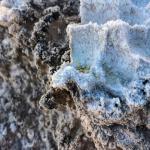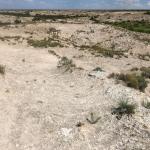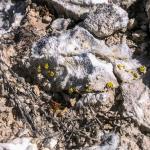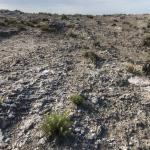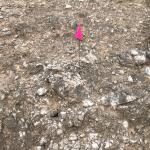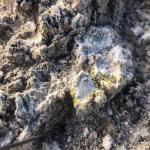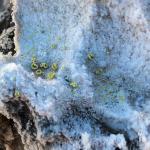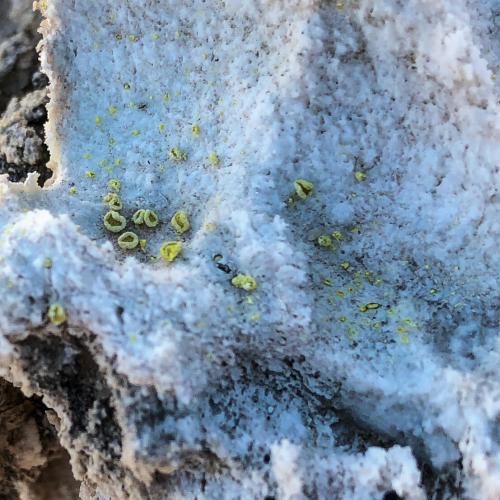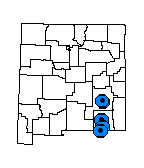Acarospora clauzadeana (A Lichen)
Biatorella clauzadeana Llimona
| USFWS | State of NM | USFS | BLM | Navajo Nation | State Rank | Global Rank | R-E-D Code | NMRPTC Status | Strategy Status |
|---|---|---|---|---|---|---|---|---|---|
| SEN | S1 | G2G3 | SS |
| Overall Conservation Status | Documented Threats | Actions Needed |
|---|---|---|
| WEAKLY CONSERVED | No information |
Status surveys on abundance, distribution and threats |
A gypsophilic, crustose disk lichen appearing as small (<1 to 2mm) raised, citrine-yellow disks on gypsum surfaces. Thallus (vegetative body of the lichen) is very sparsely developed and can be endolithic (growing within the rock crystals), citrine-yellow; apothecia (fruiting bodies) are 1.8mm in diameter, subpeltate, marginate, the margin thick, prominent, entire, pale citrine yellow, the disc at first concave, becoming planar, citrine-waxy to subolivaceous, naked; thecium (hymenium – spore bearing layer) is 75-90 µm high and the epithecium (epihymenium – uppermost portion of the hymenium) interspersed with citrine granules; paraphyses (sterile fungal filament associated with the hymenium) are thick and not capitate; spores 2-5.3 x 1.7-2.2 µm in size (Weber and Nash, 1992 and Brodo, 2001 & 2016).
None known in the area of occurrence.
This species was first described from near Almeria, Andalusia, Spain (Llimona 1974). It was subsequently collected at Quatro Cienegas, Coahuila, Mexico in 1973 by T.H. Nash (Weber and Nash 1992). In New Mexico, the initial collections were taken from a low mesa west of Bitter Lakes National Wildlife Refuge (specimen - G. Schooley 1977, annotated by T.H. Nash 1989); and from Comanche Hill east of the Pecos River (specimen - W.A. Weber & G. Schooley 1990). Recent (2019) observations/collections are from 2 new locations in Eddy County: southeast of Artesia along the Pecos River, and Yeso Hills. Current distribution in NM extends approximately 100 miles north to south. The species has been reported recently from 2 locations in Nuevo Leon, Mexico
A. clauzadeana can be common where found. It does not grow as a dense lichen cover but as minute "individual" colonies. The species occurs, in most NM situations, on eroded, sharp, saccharoid or crystalline gypsum rock. However, occurrences are recorded (contrary to the assertions of Weber and Nash 1992) on friable gypsum soils (Roswell western location), and gypsum sands (Quatro Cienegas, Coahuila, MX). The Roswell and Artesia occurrences are located on the Permian Seven Rivers Formation (or alluvium nearby); the Yeso Hills occurrences are located on the Permian Castile Formation. Based on the intercontinental distribution, the breadth of gypsum types reported occupied, and the increasing NM distribution, the species potentially occurs in any gypsum outcrop in New Mexico, as well as adjacent Texas.
The species is named after the French lichenologist F. J. Georges A. Clauzade (1914-2002) who studied French and Mediterranean lichens (Wikispecies 2020). Weber and Nash cited sources suggesting that A. clauzadeana is one of a number of lichens, bryophytes, and vascular plants with disjunct intercontinental distributions including southern Europe, Africa, and the Americas.
The location west of Bitter Lakes National Wildlife Refuge should be revisited to verify the occurrence on “friable gypsum soil” substrate as it differs substantially from other reports in eastern NM.
*Regarding vernacular names, Nature Serve provides the name “small teasel lichen” (Nature Serve 2019). Brodo et al. (2001) assign the names “cracked lichen” and “cobblestone lichen” to the genus (Acarospora) and the Plants Database (NRCS 2019) assigns “cracked lichen” to the genus.
Species is sensitive to any surface disturbing activities including mining and oil and gas exploration and development, off highway vehicle use, and potentially, vegetation management activities including chemical brush control. Indirect impacts to air quality from fugitive dust along roads could impact the species.
Brodo, I.M, S. D. Sharnoff, and S. Sharnoff. 2001. Lichens of North America. Yale Univ. Press. 795 pp.
Brodo, I. M. 2016. Keys to Lichens of North America, Revised and Expanded. Yale Univ. Press. 427 pp.
Ladyman, Juanita A.R. 1999. Online account Element Code: NLLEC02950. Nature Serve Explorer. Accessed 11/2019.
Llimona Pages, Xavier. 1974. Les comunidades de liquenes de los yesos de Espana: pg 7. Summary of The Thesis Submitted for the Degree of Doctor In Science. University of Barcelona, Secretariat of Publications, Scientific Exchange And University Extension.
Nature Serve. 2019. On-Line Encyclopedia of Life. http://explorer.natureserve.org/servlet/NatureServe?searchName=acarospora+clauzadeana
NRCS. 2019. Plants Database. Online at https://plants.usda.gov/core/profile?symbol=ACARO2
Weber, W. & T. Nash. 1992. Biatorella Clauzadeana in North America. The Lichenologist. 24(1):101-103.
Wikispecies. 2020. On-line source at
For distribution maps and more information, visit Natural Heritage New Mexico

